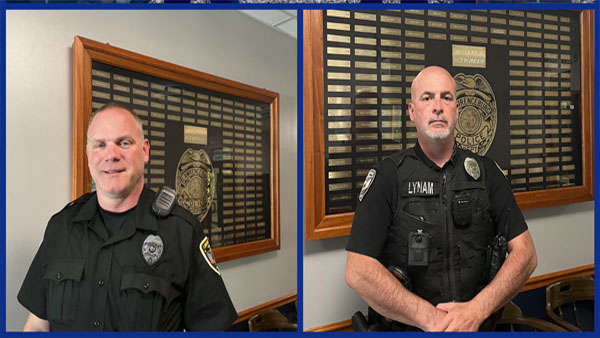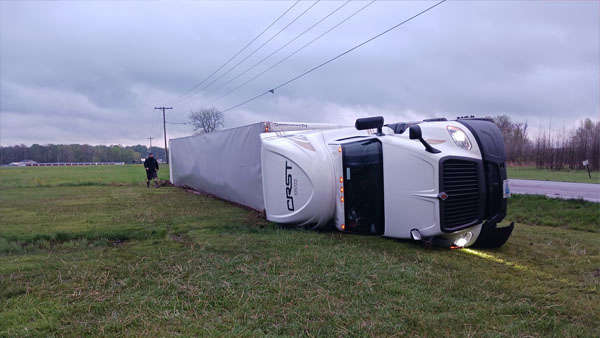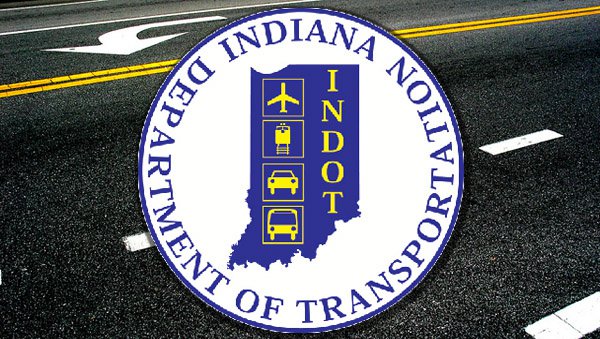Mitch Daniels and Lieutenant Gov. Becky
Skillman meet at the podium just prior to
the governor's State of the State speech
Tuesday evening.
in.gov
(Indianapolis, Ind.) - During his final State of the State address Tuesday night, Indiana Governor Mitch Daniels laid out his remaining legislative wishes and reflected on his accomplishments over his two terms in office.
But, many Democrats were not there to witness it, having walked out for the second time in the early days of the 2012 legislative session. Protestors crowding the Statehouse hallways outside the House chamber made plenty of noise in their absence, booing anytime Daniels voiced support for right to work legislation.
Daniels’ eighth State of the State address began with him thanking lawmakers and voters. Then it was time to detail his accomplishments as governor.
“Around the time I first took office, a radio caller expressed a fairly common sentiment,” Daniels said. ‘He said ‘I like what you say you stand for, but Republicans, Democrats, nothing ever changes. Nothing’s ever different.’ I recall responding, ‘Sir, I’m careful not to promise what I’m not sure can be delivered. But I’ll promise you one thing. In a few years, you may disagree with decisions we’ve made, or actions we’ve taken. But you will not think nothing’s different.’”
“I’m pretty sure that good man would agree tonight that things are very different in Indiana now,” the governor said.
Daniels bragged about balancing the state’s budget, helping Indiana obtain its first AAA credit rating, all while keeping Hoosiers property taxes among the lowest in the nation.
READ REACTION FROM AROUND INDIANA TO THE GOVERNOR'S STATE OF THE STATE ADDRESS HERE.
The governor also said Indiana has fewer state employees per capita in the country, and the fewest amount of employees since 1975.
Still “while other state governments stiff their vendors, close parks, delay tax refunds, and ignore unacceptably poor service levels, Indiana state employees are setting national standards for efficiency…,” he said. “…Our parks have never been in better shape, your tax refund comes back twice as quickly as it used to, and the average customer got in and out of a license branch last month in less than 14 minutes.”
Daniels also touted reforms to public education, improving the state’s business climate despite a national recession, increased government efficiency, and efforts to preserve 50,000 acres of wetlands and habitats.
Lawmakers who did attend the State of the State then received their wish list from Daniels, leading off with a statewide smoking ban.
“We should, at long last, enact a law to protect workers and patrons across Indiana from the hazards of second-hand smoke. Public support has grown, and so has the evidence of health risk to workers. It is time to move this long-sought objective to the finish line,” Daniels said.
A bill has been filed in the state legislature to enact a smoking ban. It could receive a House committee hearing soon.
GIVE US YOUR THOUGHTS ON THE GOVERNOR'S 2012 STATE OF THE STATE SPEECH ON EAGLE 99.3'S FACEBOOK PAGE.
Daniels then delved into Indiana’s most hot-button issue – becoming the nation’s 23rd right to work state.
“Hoosiers support the principle known as Right to Work. After a year of studying the proposal, I agree,” he said. “The idea, that no worker should be forced to pay union dues as a condition of keeping a job, is simple, and just. But the benefits in new jobs would be large: a third or more of growing or relocating businesses will not consider a state that does not provide workers this protection.”
Daniels said Indiana misses out on new employers moving into the state because there are no right to work laws.
“I did not come lightly, or quickly, to the stance I take now. If this proposal limited in any way the right to organize, I would not support it. But we just cannot go on missing out on the middle class jobs our state needs, just because of this one issue,” the governor said.
Meanwhile, crowds of union members and protestors lamented the governor’s comments on right to work with boos.
Daniels referenced a letter written by a clerk in 1861, which referenced a duel between two legislators who were at odds. Those 19th century lawmakers – a Republican and Democrat – agreed to a duel with bowie knives and neither were heard from since.
“And we think we have disagreements! When we do, I hope we’ll keep them not only in state, but also in this Chamber, where the people’s business is supposed to be settled,” Daniels said.
Before concluding, Daniels also asked lawmakers to address other pressing issues:
Strengthen human trafficking laws in advance of Indianapolis hosting the Super Bowl February 5.
The amount of money awarded to victims of the Indiana State Fair stage collapse last August should be increased.
The Indiana Higher Education Commission should be empower to limit “credit creep,” or cut back on the number of credit hours the state’s colleges require for some degrees in hopes of increasing graduation rates.
Continue to pursue for local government reforms.
Daniels would conclude his final State of the State by saying if Indiana continues its current path, it will continue to be the state Hoosiers have dreamed of.
“A state that magnetizes people of talent, and the risk-taking capital that seeks to employ them. A state of growth. A state of hope. A state of promising futures. We are not yet fully that state. But we are so much closer to it. We have leapfrogged other places, passed more competitors than Tony Stewart at Homestead. We are certainly, irrefutably, different,” he said.
Here is the full text of the governor’s 2012 State of the State address:
Members of the General Assembly, honored guests, fellow citizens. For an eighth time, and the final time, you afford me the unrivaled privilege of this podium. As it’s my last such chance to express my appreciation for the public service you each perform, and to Hoosiers for hiring me twice so I could try to perform my own, I’ll start with a heartfelt thank you.
But the time for reminiscing will come later, much later. Tonight, and all nights in today’s Indiana, must be about the future, where we are and where we are going.
A reporter asked recently, “What keeps you up at night?” I replied that I generally sleep well, but if I ever do have trouble, I don’t have to count sheep. I count all the states I’m glad I’m not the governor of.
Around the time I first took office, a radio caller expressed a fairly common sentiment. He said “I like what you say you stand for, but Republicans, Democrats, nothing ever changes. Nothing’s ever different.” I recall responding, “Sir, I’m careful not to promise what I’m not sure can be delivered. But I’ll promise you one thing. In a few years, you may disagree with decisions we’ve made, or actions we’ve taken. But you will not think nothing’s different.”
I’m pretty sure that good man would agree tonight that things are very different in Indiana now. Then, we were broke and other states were flush. Tonight, while states elsewhere twist in financial agony, Indiana has an honestly balanced budget, a strong, protective reserve in our state savings account, and the first AAA credit rating in state history, one of just a handful left in America. Our credit is better – imagine this – than that of the federal government.
Another host of states raised taxes again last year, while Hoosiers are taxed at the lowest levels in a long time, thanks in part to the lowest property taxes in the nation.
While other state governments stiff their vendors, close parks, delay tax refunds, and ignore unacceptably poor service levels, Indiana state employees are setting national standards for efficiency.
Tonight, Hoosiers are served by provably the most productive government workers anywhere. Indiana has the fewest state employees per capita in the country, the fewest we’ve had since 1975. And yet our parks have never been in better shape, your tax refund comes back twice as quickly as it used to, and the average customer got in and out of a license branch last month in less than 14 minutes.
I’m not the only one to notice. In a national survey last summer, 77 percent of Hoosiers described their state government as “efficient,” far above most states and the second-highest rating in the nation.
Uniquely in public sector America, Indiana now pays state workers on a performance basis, so those doing the best job are properly rewarded for their superior efforts. But I know that the reward they value as much as money is simple recognition from the citizens they serve, and I hope you’ll show them right now that you value them and their hard work as much as I do.
Careful stewardship of the taxpayer’s dollar, and ceaseless efforts to improve public services, are matters of duty, and basic good government. But they are not the fundamental goals of public life. They are just means to the real goal, which is to make of our state a place of opportunity, and upward mobility, and a better standard of living. A place where young people, and people not so young, know that they can start with nothing and make a good life. From our administration’s first day, this has been the central objective around which everything else was organized.
We have worked relentlessly to move Indiana up the list of great places to do business. We set out to build the best sandbox in America, a place where men and women of enterprise knew that, if they risked a buck on their idea or their dream, they would have the best possible chance to get it back, with something left over they could use to hire the next Hoosier.
We have made steady progress, coming from nowhere to the top tier in every ranking: No. 6 according to the nation’s site selectors, No. 6 according to CEO Magazine, No. 5 according to real estate decision makers.
But it isn’t nearly enough. It was our ironic bad luck to create a top economic climate just as the nation plunged into its worst modern recession, and business investment slowed to a crawl: we became the prettiest girl in school the year they called off the prom.
Despite these headwinds, our recently strong state revenues show that something positive is happening to Hoosier incomes. In 2010, the most recent data we have, Indiana incomes grew at the eighth fastest rate in the country.
Here’s another encouraging sign: more people are moving into Indiana than moving out. Our population is growing at the fastest rate from Iowa to Maine. Maybe best of all, thousands more college graduates moved into our state last year than moved out. There is no better indicator of economic promise in today’s world than success at attracting top talent, and we are.
We are not where we want to be, nowhere close. But with a welcoming business climate, enormous investments in new public infrastructure, and a stable fiscal picture, we are poised for more progress, and better days.
Beyond the statistics lies a more basic difference in the Indiana of today: we are now, indisputably, seen as a leader. In hundreds of articles about fiscal prudence, economics, transportation, corrections, child protection, we are cited constantly now as an example for others to examine. From Cleveland: “Ohio should follow Indiana’s lead and dive in.” From Detroit: “Indiana has many of the answers…as seen in Indiana it certainly is possible.” From North Carolina: “Fortunately, there’s no need to speculate about how a state might proceed...Indiana has already done it.”
It’s more than words. We now experience the sincerest flattery all the time: our Economic Development Corporation has been copied by Ohio, Wisconsin, Michigan, Iowa among others; our corrections programs by Oregon; our employee health care by Oklahoma, Missouri, and Florida; our performance-based personnel policies by Tennessee and Wyoming; our air quality modeling and permitting by Kentucky and South Carolina; our online university, WGU Indiana, by Texas and Washington. And, at every governors meeting, someone says “If only we could pull off a deal half as good as Indiana did with its Toll Road.”
The latest realm in which Indiana is now a leader is perhaps the most important. From coast to coast, others are praising our reforms of public education. One national magazine wrote that Indiana has gone “from the backwaters of education reform in America to the front.” The Fordham Institute said “No one has been more successful in providing a comprehensive reform plan for a system that is failing America’s children.” And then there’s this, from even further away: the Daily Telegraph of London wrote that in education, “England would do well to follow Indiana’s lead.”
The days when education debates started and stopped at dollar signs are over, and high time. From President Obama down, everyone now recognizes that leaders in education are defined not by what they put in but by what they get out. But just for the record, and despite frequent misrepresentations to the contrary, Indiana is a leader in what we put in.
With this year’s spending increases, plus the additional funds we requested for full day kindergarten, K-12 spending is now 56 percent of the entire state budget, the highest percentage of any state in the nation. No state anywhere devotes more of its state funds to education.
But that’s not why others are following Indiana. It’s our new commitment to rewarding the best teachers, liberating principals and superintendents, and providing low- and middle-income parents the same choices as their wealthier neighbors; that’s what has caught the world’s attention. And this year, when we end the cruel, defeatist practice of passing children who cannot read into fourth grade, and when our most diligent students begin to graduate from high school in 11 years, and get a head start on college costs with the dollars they earned through their hard work, others will take notice of Indiana yet again.
There are few subjects more studied, or more intriguing, than leadership. Leaders come in many forms and often from unexpected directions. But some qualities are common among them, and one is that leaders never loaf. They never slip into complacency, settle for things as they are, or stop pursuing innovation and excellence of result. If they do, leadership will pass, and new leaders surpass. Leaders who loaf aren’t leaders for long.
Along with all the accolades, Indiana now bears this burden of leadership, the duty to keep pressing ahead.
This administration will not loaf. We have made out a long list of self-assignments for our eighth and final year. Our Economic Development Corporation captured a record 219 new jobs transactions in 2011; we have raised the bar to 250 for the year ahead.
We will press hard to accelerate further the ahead-of-schedule, under-budget delivery of our Major Moves transportation program. In 2012, we will invest $1.2 billion in road and bridge construction, the sixth straight record-setting year.
The last contract on the Hoosier Heartland Corridor will be let next summer and the entire project finished by 2013. The last contracts on U.S. 31 from South Bend through Kokomo will be let this year, and we have accelerated completion of the entire corridor into 2015. I-69 will be open for traffic from Evansville to Crane, as will the entire Fort to Port highway in Northeast Indiana. The Sherman-Minton Bridge will be rebuilt and reopened by March and, upriver, an agreement on a new bridge from Utica to Louisville will be in place, cementing Indiana’s place at the forefront of the public-private partnership movement.
We will build the state’s 3,000th mile of bike and hiking trails, and reach our goal of a trail within 15 minutes of every Hoosier.
Unknown to most citizens, the air and water of Indiana is now the cleanest in living memory. In 2011, every Indiana community met all national air quality standards for the first time in the history of the Clean Air Act.
Last year, we wiped out the last of a 550-case backlog of old, and therefore less strict, environmental permits, and are now the only state completely current. Our goal for 2012 is to maintain this status and, if national limits are lowered yet again, to find a way to meet those standards, too.
We will complete our successful overhaul of what was once America’s worst welfare system when, in February, the 10th and final region is converted to our reformed, public-private system. Backlogs have been slashed by 80 percent, timeliness and accuracy have soared above national averages, and last October the program earned a cash bonus and an award for most improved in the nation. We have set high targets for continued improvement in 2012.
The same is true of our campaign to conserve Indiana’s natural heritage. The last seven years have seen new records for protection of wetlands and habitats, 50,000 acres by the end of this year, highlighted by the largest such project ever at Goose Pond. In 2011, we launched new waterways conservation projects the size of three Goose Ponds in the Muscatatuck Bottoms, and five Goose Ponds along the Wabash Corridor. Before long, Hoosiers will be able to travel over 100 miles down our state’s signature river and never leave a protected wetlands.
Our coming Bicentennial gives us an ideal opportunity to extend this historic era of reverence for the beauty God bestowed on Indiana. I have appointed a commission of a dozen illustrious citizens, led by my partner Becky Skillman, and by the legendary Congressman Lee Hamilton, to guide the great celebrations to come.
As a first initiative, I have asked them to oversee a Bicentennial Nature Trust, a statewide project to protect still more of our most precious natural spaces. On our 100th birthday, Indiana launched its state park system. A statewide conservation initiative is a fitting sequel and bequest from our second century to our third.
We have identified state funding, within existing resources, of $20 million, but that must be just a beginning. The Trust is intended to inspire others, and to match their donations of land or dollars in a continuing statewide surge of conservation. The Commission joins me in challenging citizens, businesses, and in particular our unique network of county community foundations, to identify and fund local projects that will safeguard places of beauty for future generations.
In this Assembly, you too must set big goals. We should, at long last, enact a law to protect workers and patrons across Indiana from the hazards of second-hand smoke. Public support has grown, and so has the evidence of health risk to workers. It is time to move this long-sought objective to the finish line.
We should – no, we must – strengthen our laws against the horrid practice of human trafficking, and we must do it in time for the Super Bowl, the kind of event at which the exploitation of young women is rampant in the absence of such a tough law.
We should assist students with the cost of higher education by empowering our Higher Ed Commission to limit the “credit creep” which unduly increases both time to graduation and student expense. Undoubtedly, some degrees will continue to justify more than the traditional 120 credit hours. But schools requiring 126 hours for a degree in sociology, or 138 hours in special education, or 141 hours in music education, should have to explain why all that time and student expense is necessary, especially when other colleges offer high quality programs in less time and cost.
We should deepen the state’s response to the terrible tragedy that befell so many at last summer’s Indiana State Fair. A catastrophe so singular merits unique treatment, and I hope you will augment the amounts already provided the victims and their families by the state and private donors.
And we should trust the people of Central Indiana with the decision whether to raise local dollars for mass transit if they believe it crucial to their future quality of life.
Within weeks, one of the great public careers, and perhaps the greatest judicial career, our state has known will come to a close. Chief Justice Randy Shepard, let tonight be one of many occasions on which a grateful and fortunate state thanks you for a quarter century of fairness, firmness, and farsightedness on our highest bench.
Part of Justice Shepard’s legacy will be the landmark report that he and former Governor Joe Kernan co-authored, proposing overdue modernization of our pioneer days structures of local government. One way to honor this great public servant will be to advance more of the sensible and needed reforms set forth by the Kernan-Shepard Commission. I ask this Assembly to do so, on their own merits but also in recognition of this historic public servant.
Because economic opportunity, and building America’s best home for jobs, is the central goal of all we do, every year should include a bold stroke to enhance it. This year, the choice of actions has become obvious.
In survey after survey, by margins of 2 to 1 or more, Hoosiers support the principle known as Right to Work. After a year of studying the proposal, I agree.
The idea, that no worker should be forced to pay union dues as a condition of keeping a job, is simple, and just. But the benefits in new jobs would be large: a third or more of growing or relocating businesses will not consider a state that does not provide workers this protection.
Almost half our fellow states have right to work laws. As a group, they are adding jobs faster, growing worker income faster, and enjoying lower unemployment rates than those of us without a law. In those ratings of business attractiveness I mentioned, the only states ahead of us are right to work states.
What every economic development expert has testified to, we have learned from firsthand experience: over seven years and well over a thousand job competitions, we have found that, when Indiana gets a chance to compete, we win two out of three times. But too often we never get a chance, because a right to work law is a requirement. Especially in this poor national economy, a state needs every edge it can get.
Everyone knows that, among the minority favoring the status quo, passion on this issue is strong, and I respect that. I did not come lightly, or quickly, to the stance I take now. If this proposal limited in any way the right to organize, I would not support it. But we just cannot go on missing out on the middle class jobs our state needs, just because of this one issue.
For the sake of those without jobs, and those young people just beginning the ascent of life’s ladder, I ask you to remove this obstacle and make Indiana the 23rd state to protect the right to work.
I have a new prized possession. It is a letter, written to his parents by a young clerk named A.B. Carpenter, on February 12, 1861. Amid updates about haircuts, colds, and headaches, young Mr. Carpenter reported the following: “There is…considerable excitement concerning a couple of legislators who went to Kentucky to fight a duel. Mr. Heffern, a Democrat, slandered and abused Mr. Moody, a Republican in a speech and Moody challenged him. He accepted and choosed bowie knives. They went to Kentucky last Friday night and have not been heard from since.”
And we think we have disagreements! When we do, I hope we’ll keep them not only in state, but also in this Chamber, where the people’s business is supposed to be settled.
Mr. Carpenter’s letter wasn’t mainly about duels or haircuts. He wrote it because he had gone to see the newly-elected President, Abraham Lincoln, who had spent that day, his 52nd birthday, in Indianapolis. Young Carpenter described Lincoln’s arrival at Lafayette Road, the procession down Washington, Pennsylvania, Ohio and Illinois Streets to the Bates House hotel.
Seeing the new President filled Carpenter with hope, he said, that “(S)oon our government will be remodeled.“ I like the term. These measures I have mentioned are part of our continuing remodeling project.
In three weeks, the entire world will fix its eyes on this city, and our state. It should be a magic moment, I hope a matter of pride to every Hoosier everywhere.
But the Super Bowl didn’t get here overnight. Indy’s selection followed decades of constant striving, and building, and reforms to make our capital the vibrant, livable model city it has now become. No one leader, or group of leaders, made it happen. The work was passed from hand to hand, administration to administration, generation to generation, and in no era did the people of Indianapolis rest, or settle, or loaf. So it will have to be with the construction of the great Indiana we are determined to achieve.
I carried here from its place on my desk an atomic clock, given me by a friend who served a sister state as governor with great distinction. It sits directly in front of me each day, counting down the days, hours, minutes, and seconds until I turn over these duties and return to private life. It is there to remind me to use every moment as well as I can to make Indiana a place of greater promise and prosperity. Silently, it challenges me to search each day for the next improvement, the next efficiency, the next breakthrough, the next stroke of Indiana leadership.
Yes, these nights are about the future, but I do look back at past speeches, if only to avoid repeating myself. In one, I recounted telling an East Coast CEO who wondered what Indiana was known for that one day he wouldn’t have to ask. Tonight, he doesn’t.
In another, I said I hoped we would become bolder in our embrace of change, take our motto from the inspiring athletes of the Special Olympics, and be a braver state. Tonight, we are.
In the very first of these meetings, I invited you and every Hoosier listening to join us in rejecting mediocrity, demanding excellence, aiming higher. Tonight, we do.
In a column titled “Indiana promises a better future,” a young graduate student, a lifelong resident of a neighboring state, wrote to the Indianapolis Star that she had made a critical life decision. She would take her new degree and move to Indiana. She cited our “fiscally responsible choices,” our “economic integrity,” our avoidance of the “out-of-control spending we see in so many other states.” She concluded by predicting that more talented young people would make “that short drive down I-69 to a more promising future.”
That is the state we have dreamed of. A state that magnetizes people of talent, and the risk-taking capital that seeks to employ them. A state of growth. A state of hope. A state of promising futures.
We are not yet fully that state. But we are so much closer to it. We have leapfrogged other places, passed more competitors than Tony Stewart at Homestead. We are certainly, irrefutably, different.
Until it became real, I never imagined that, for eight fulfilling years, I would be given the chance to help make Indiana different. On the night it became real, I resolved to use every day, take every action, make every change that might make our state a place of promising futures.
I now have 369 days, __hours, ___minutes, and __seconds left as the people's employee. I pledge to use every one of them, as wisely as I can, in the service of those who sent us to this chamber. I ask you to do likewise, to be t

 Switz. Co Sheriff's Office Seeking Info About Stolen Excavator
Switz. Co Sheriff's Office Seeking Info About Stolen Excavator
 Ohio County Community Foundation Receives $300,000 Grant
Ohio County Community Foundation Receives $300,000 Grant
 City of Lawrenceburg Recognizes Two Officers for Life-Saving Actions
City of Lawrenceburg Recognizes Two Officers for Life-Saving Actions
 No Injuries in Semi Accident Near Versailles
No Injuries in Semi Accident Near Versailles
 EC's Stenger Selected to IHSAA Student Advisory Committee
EC's Stenger Selected to IHSAA Student Advisory Committee
 Indiana Drivers Urged to Travel Safely in Work Zones
Indiana Drivers Urged to Travel Safely in Work Zones












